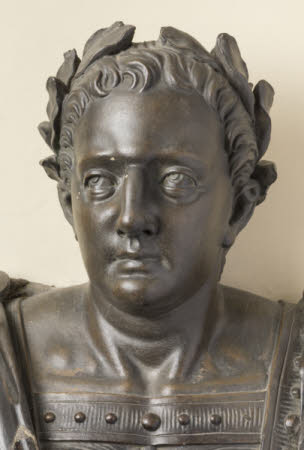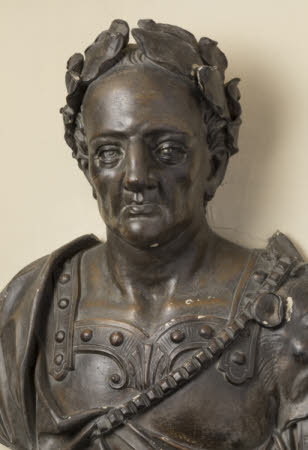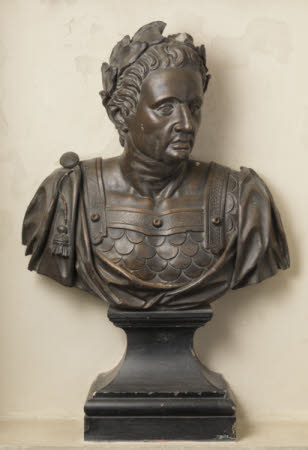The Caesars
workshop of Matthew Brettingham the Younger (1725 - 1803)
Category
Art / Sculpture
Date
circa 1758 - 1769
Materials
Bronzed plaster
Place of origin
London
Order this imageCollection
Kedleston Hall, Derbyshire
NT 108999
Summary
Bronzed plaster, the Caesars, c.1758-69, probably cast in Britain after the antique. A set of nine plaster busts of the Caesars, 'bronzed' (painted to look like bronze), installed in the eponymous Caesar's Hall at Kedleston: NT 108999.1 Nerva, Roman Emperor (reign 98-117 AD) NT 108999.2 Tiberius, Roman Emperor (reign 14-37 AD) NT 108999.3 Titus, Roman Emperor (reign 79-91 AD) NT 108999.4 Nero, Roman Emperor (reign 54-68 AD) NT 108999.5 Gaius Julius Caesar (100-44 BC; Roman politician and military general, his adoptive son Augustus (Octavian) became the first Emperor of Rome) NT 108999.6 Hadrian, Roman Emperor (reign 117-138 AD) NT 108999.7 Augustus, Roman Emperor (reign 27-14 AD) NT 108999.8 Commodus, Roman Emperor (reign 180-192 AD)
Full description
No invoices or receipts exist for this group of busts - as they do for some of the statues and Library busts - however Matthew Brettingham's Account Books show that by January 1755 he had purchased from Rome the moulds for sixty busts, divided between a set of 30 Greek portraits and 30 Roman, so it is plausible that the Caesars may originate from Brettingham (Brettingham in Kenworthy-Browne 1983, pp.100, 102). Brettingham had returned to London with these moulds, as well as moulds for full-size statues after the antique, and had brought with him, at great expense, and Italian craftsman to cast from moulds in England. A bill of 23 January 1758 shows that Brettingham acquired five casts of full-size antique statues for Nathaniel Curzon (1726-1804), which are now in the Marble Hall, and five busts of Greek and Roman figures, which are now in the Library (MS, Kedleston Hall Archive). Around two years later Curzon made an inventory of his statuary which states that 26 'Plaister Busts' were in the collection at Kedleston, although only sixteen are listed and these do not include the Caesars (MS, Kedleston Hall Archive). We can be certain that the group were installed in Caesar's Hall by 1769 as they appear in the printed 'Catalogue of the pictures, statues, &c. at Kedleston' (p.4), and were displayed alongside medallions of Homer, Hesiod, Horace and Tully. Alice Rylance-Watson February 2019
Provenance
Purchased by Nathaniel Curzon, 1st Lord Scarsdale (1726-1804); identifiable as 'Busts of the Cesars' in 'Catalogue of the pictures, statues, &c. at Kedleston[...]', 1769, p.4; identifiable as 'Busts of the Cesars' in 'Catalogue of the pictures, statues, &c. at Kedleston[...]', 1861, p.4; purchased with part of the contents of Kedleston Hall with the aid of the National Heritage Memorial Fund in 1986 when the house and park were given to the National Trust by Francis Curzon, 3rd Viscount Scarsdale (1924-2000).
Credit line
Kedleston Hall, The Scarsdale Collection (acquired with the help of the National Heritage Memorial Fund and transferred to The National Trust in 1987)
Makers and roles
workshop of Matthew Brettingham the Younger (1725 - 1803), caster
References
Kenworthy-Browne 1983: John Kenworthy-Browne, 'Matthew Brettingham's Rome Account Book 1747-1754', The Volume of the Walpole Society, vol.49 (1983), pp.37-132, pp. 100, 102



























